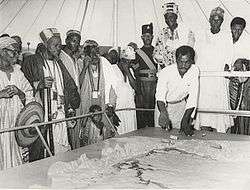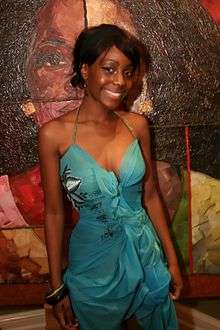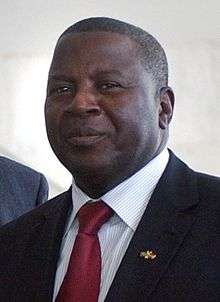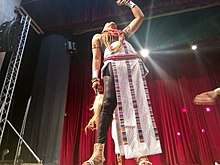Dagomba people
[2]The Dagombas are a Gur ethnic group of northern Ghana, numbering about 931,000 (2012).[1] They inhabit the Northern Region of Ghana in the sparse savanna region below the sahelian belt, known as the Sudan. They speak the Dagbani language which belongs to the More-Dagbani sub-group of the Gur languages. There are around 1 million speakers of Dagbani. The Dagomba are historically related to the Mossi people. The More/Mossi now have their homeland in central present-day Burkina Faso. The homeland of the Dagomba is called Dagbon and covers about 20,000 km2 in area.
| Total population | |
|---|---|
| 1,197,937[1] (2019 est.) | |
| Regions with significant populations | |
| Northern Ghana | |
| Languages | |
| Dagbani, Mòoré, Hausa, French, English | |
| Religion | |
| Sunni Islam, with several Christian minorites. | |
| Related ethnic groups | |
| Mossi, Mamprusi, Frafra, Gurunsi, other Gur peoples |
| People | Dagomba |
|---|---|
| Language | Dagbani |
| Country | Dagbon |
Na Gbewa is regarded as the founder of Dagbon. Dagomba are one of the ethnic groups with a sophisticated oral tradition woven around drums and other musical instruments. Thus, most of their history, until quite recently, has been passed down via oral tradition with drummers as professional griots. According to oral tradition, the political history of Dagbon has its origin in the life story of a legend called Tohazie (translated as "red hunter").[3]
Dagomba culture is heavily influenced by Islam, brought to the region by Soninke (known as Wangara by Ghanaians) traders between the 12th and 15th centuries. Since the time of Naa Zangina, Islam has been the state religion and Islam seems to be growing rapidly ever since.[4] The reformist activities of Afa Anjura in the middle of the twentieth century caused entire communities to embrace the Islamic religion en masse. Inheritance in the Dagomba people is patrilineal. Important festivals include the Damba, Bugum (fire festival) and the Islamic Eid festivals. The main settlement of the Dagomba is Tamale, which also serves as the Northern Region's capital.
The Mossi and Dagomba states are among the great West African medieval empires. Beginning in the 12th century, they eventually ruled the lands of the entire northern Volta basin, which today includes all of northern Ghana and Burkina Faso. During their second northern expansion, the Mossi invasion reached eastern Maasina and Lake Débo c. 1400, Benka in c. 1433 and Walata in 1477-83 (these empires were in present-day Mali). According to Dr Illiasu (1971) in his work The Origins of the Mossi-Dagomba states, the second period of the Mossi-Dagomba success came to an end with the restoration of Imperial Songhai power towards the close of the 15th century. Although the Mossi-Dagomba states have the same grandfather (Na Gbewa), the Dagomba are traditionally regarded as "senior" to the Mossi states of Ouagadougou, Yatenga and Fada N'Gourma.
Origins

The Dagombas migrated from around the areas of Lake Chad after the break up of the Ghana Empire at the end of the 13th Century.[5][6]
Kingdom of Dagbon
The homeland of the Dagombas is called Dagbon and covers about 20,000 km2 in area. Much of the area was occupied by Konkombas before the formation of Dagbon Kingdom. It forms part of the Northern Region of Ghana, which includes the Mamprusi, Nanumba, Gonja, Mossi, Gurunsi (in particular the Frafra and Kusasi peoples), the Wala people and Ligbi. The area constitutes fourteen administrative districts in present-day Ghana. These are the Tamale Metropolitan, Yendi, Savelugu and Sagnerigu municipals, and Tolon, Kumbungu, Nanton, Gushegu, Karaga, Zabzugu, Saboba, Sang, Tatale and Cheriponi districts. The king of the Dagbon Traditional Kingdom is the Ya-Na, whose court and administrative capital is at Yendi. Dagbon as a kingdom has never been subjugated until it was incorporated as a territory of the Gold Coast government. The Dagbon Kingdom has traditional administrative responsibilities hitherto acephalous groups like the Konkomba, Bimoba, Chekosi, Basaari, Chamba, Wala, Gurusi and Zantasi. The seat of the Ya-Na or king of Dagbon (literally translated as "King of Absolute Power") is a collection of cow skins. Thus, the Dagbon or its political system is often called the Yendi Skin (not throne or crown or stool). Another characteristic of the Dagomba is that their houses are arranged in a certain order, where the chief or elderly man has his hut built in the centre.[7]
Chieftancy
One of the major features of Dagomba society is chieftaincy. Their system of chieftancy is very hierarchical, with the Yaa-Naa, or paramount chief, at its head and a tiered system of rulers below him. In Dagbon, chiefs traditionally sit on a stack of skins[8]
Notable Dagombas
- Yakubu II - Last King of Dagbon.
- Aliu Mahama - Former Vice President of Ghana from 2000 to 2008.
- Haruna Yakubu - A past Vice Chancellor of University for Development Studies.
- Haruna Iddrisu - A Ghanaian politician.
- Afa Ajura - founder and leader of the Ahlus Sunnah wal Jamaa'a Islamic sect in Ghana
See also
References
- "Ghana Population 2019".
- "Dagomba | people". Encyclopedia Britannica. Retrieved 2020-05-24.
- St.John Parsons, D. 1968, Legends of Northern Ghana. London : Longmans.
- A. K. Awedoba; Edward Salifu Mahama; Sylvanus M. A. Kuuire; Felix Longi (October 20, 2010). An Ethnographic Study of Northern Ghanaian Conflicts: Towards a Sustainable Peace. Sub-Saharan Publishers; revised edition. ASIN 9988647387.
- Zakaria, A. B. "Migrant Chiefs in Urban Ghana: The Case of the Dagomba Chiefs in Accra".
- "Virtual Kollage: The pre-colonial political orgaization of the Mole-Dagbani ethnic group of Ghana". www.virtualkollage.com. Retrieved 2019-10-18.
- "Dagomba in Ghana". Retrieved March 23, 2014.
- "dagomba | About the Dagomba". Retrieved 2020-05-24.




